- Tips for Planting Grape Cuttings in Autumn
- 1. Selecting the Right Cuttings
- 2. Pruning Techniques
- 3. Proper Planting Methods
- 4. Maintenance
- Understanding the Pruning Technique
- Selecting the Right Cuttings for Planting
- Preparing the Soil for Planting
- 1. Soil Testing
- 2. Clearing the Area
- 3. Loosening the Soil
- 4. Adding Organic Matter
- 5. Fertilizing
- 6. Creating Planting Holes
- 7. Watering
- Creating the Proper Planting Hole
- Ensuring Proper Drainage for Successful Planting
- 1. Choosing well-draining soil
- 2. Preparing the planting site
- 3. Amending the soil
- 4. Creating a drainage slope
- 5. Using raised beds or mounds
- 6. Adding drainage materials
- 7. Monitoring moisture levels
- Planting the Grape Cuttings
- 1. Select a Suitable Planting Site
- 2. Prepare the Soil
- 3. Prune the Grape Cutting
- 4. Plant the Grape Cutting
- 5. Water the Grape Cutting
- 6. Provide Support
- 7. Monitor and Maintain
- Caring for Newly Planted Grape Cuttings
- 1. Watering
- 2. Mulching
- 3. Fertilizing
- 4. Pruning
- 5. Protection
- Monitoring the Growth and Development
- 1. Watering
- 2. Leaf Development
- 3. Shoot Growth
- 4. Pest and Disease Control
- 5. Nutrient Levels
- 6. Support and Training
- Question-answer:
- What are some pruning techniques to consider when planting grape cuttings in autumn?
- What are the proper planting methods for grape cuttings in autumn?
- Can grape cuttings be planted in autumn or should I wait until spring?
- What happens if I don’t prune grape cuttings when planting them in autumn?
- What are some common mistakes to avoid when planting grape cuttings in autumn?
- Video: Pruning Grapes | How to prune grapes vine | Spur Pruning | Paano magpabunga ng grapes
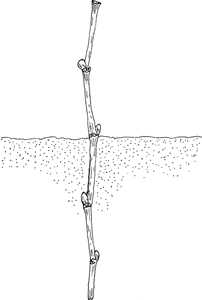
Autumn is the perfect time to plant grape cuttings, as the cooler temperatures and moist soil create ideal conditions for root establishment. Proper pruning techniques and planting methods are crucial for the success of your grape vines. In this article, we will explore some helpful tips to ensure a successful grape planting experience.
Firstly, it is important to choose healthy and disease-free grape cuttings. Look for cuttings that are about 12 to 18 inches long and have several buds. Trim off any damaged or diseased parts before planting. This will help prevent the spread of diseases and ensure that your grape vines have a strong foundation.
Next, pruning is an essential step in preparing grape cuttings for planting. Pruning helps to stimulate growth and establish a strong root system. Remove all but the top two or three buds from each cutting. This will encourage new growth and improve the overall health of the vine. Additionally, remove any side shoots or tendrils to redirect the plant’s energy towards root development.
When it comes to planting grape cuttings, proper technique is crucial. Dig a hole that is deep enough to accommodate the entire cutting, ensuring that at least two buds are below the soil surface. Place the cutting in the hole and backfill it with soil, making sure to firm it gently around the base of the cutting. Water the newly planted cuttings thoroughly to ensure proper hydration.
In conclusion, planting grape cuttings in autumn requires proper pruning techniques and planting methods. By selecting healthy cuttings, pruning them correctly, and planting them with care, you can ensure the success of your grape vines. Follow these tips to enjoy a bountiful harvest of delicious grapes in the seasons to come.
Tips for Planting Grape Cuttings in Autumn
Planting grape cuttings in autumn is a great way to establish new vines and ensure a bountiful harvest in the future. Here are some tips to help you successfully plant your grape cuttings:
1. Selecting the Right Cuttings
When choosing grape cuttings, make sure to select healthy, disease-free vines. Look for cuttings that are at least 12 inches long and have at least 4 buds. This will ensure that the cutting has enough energy and potential for growth.
2. Pruning Techniques
Before planting the cuttings, it is important to prune them properly. Remove any leaves and lateral shoots to focus the energy of the cutting on root development. Trim the top of the cutting to encourage new growth.
3. Proper Planting Methods
When planting grape cuttings, dig a hole deep enough to accommodate the entire cutting, leaving about 2-3 buds exposed above the soil. Make sure to space the cuttings at least 6 feet apart to allow for proper growth and air circulation.
It is also important to choose a location with well-draining soil and ample sunlight for the vines to thrive. After planting, water the cuttings thoroughly and provide a trellis or support system for the vines to grow on.
4. Maintenance
Regularly check the cuttings for any signs of pests or diseases. If necessary, treat the vines with appropriate fungicides or insecticides. Prune the vines during the dormant winter months to remove any dead or damaged wood.
Additionally, provide regular irrigation to ensure the cuttings receive enough water. Mulching around the base of the vines can help conserve moisture and suppress weeds.
By following these tips, you can increase the chances of successful grape cutting planting in autumn. With proper care and maintenance, you can look forward to enjoying a bountiful harvest of delicious grapes in the future.
Understanding the Pruning Technique
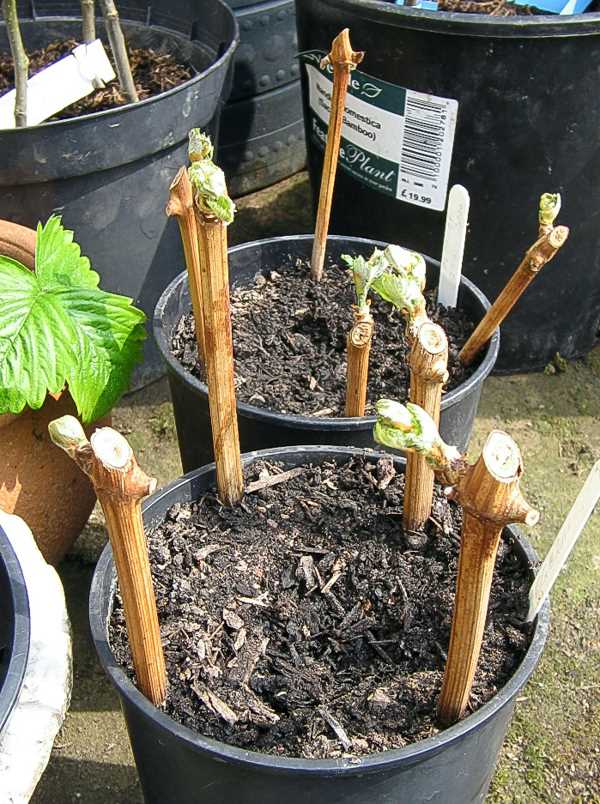

Proper pruning technique is essential for successful grape cultivation. Pruning helps to control the growth of the vine, promote the production of high-quality grapes, and ensure good airflow and sunlight penetration. Here are some key factors to understand about pruning grapevines:
- Timing: Pruning should be done during the dormant season, typically in late winter or early spring, before the buds start to grow. Autumn is not an ideal time for pruning grape cuttings.
- Pruning Goals: The main objectives of pruning grapevines include removing old or dead wood, maintaining the desired shape and size of the vine, and promoting the growth of fruiting wood.
- Tools: Use sharp and clean pruning shears or loppers to make clean cuts. Disinfect the tools between cuts to prevent the spread of any diseases.
- Training System: Different grape varieties may require different training systems, such as the cordon system or the high-wire system. Understand the specific training system recommended for your grape variety and prune accordingly.
- Pruning Cuts: When making pruning cuts, aim for a 45-degree angle and cut just above a bud. This encourages new growth in the desired direction.
- Thinning and Renovation: Regularly thin out excess shoots and canes to allow for better air circulation and sunlight exposure. In older vines, consider renovating by removing some of the older wood and encouraging new growth.
Remember, proper pruning technique takes time and practice to master. It is important to follow the specific guidelines for your grape variety and seek advice from local experts or agricultural extension services for the best results.
Selecting the Right Cuttings for Planting
When it comes to planting grape cuttings in autumn, selecting the right cuttings is crucial for the success of your grapevine. Here are some tips to help you choose the best cuttings:
- Choose Healthy Cuttings: Look for cuttings that are free from any diseases or pests. Inspect the cuttings carefully for any signs of damage, discoloration, or deformities. Healthy cuttings are more likely to grow successfully.
- Consider the Variety: Different grape varieties have different characteristics and requirements. Consider the specific variety that you want to plant and select cuttings from a healthy and productive vine of that variety.
- Age of the Cuttings: Select cuttings that are one-year-old. Older cuttings may have a lower success rate when it comes to root development and overall growth.
- Size of the Cuttings: Choose cuttings that are about 12-18 inches in length. Cuttings that are too short may not have enough stored energy to develop roots, while cuttings that are too long may be more difficult to handle and plant.
- Look for Nodes: Nodes are the buds on the cuttings from where new growth will emerge. Make sure the selected cuttings have at least 2-3 nodes to increase the chances of successful rooting and growth.
- Remove Leaves: Before planting the cuttings, remove any leaves from the lower nodes. This will promote better root development and prevent excessive moisture loss from transpiration.
Preparing the Soil for Planting
Before you start planting grape cuttings in autumn, it is essential to prepare the soil to provide the best conditions for their growth and development. Proper soil preparation will ensure that the plants receive the necessary nutrients, drainage, and moisture retention.
1. Soil Testing
Before preparing the soil, it is recommended to perform a soil test to determine its pH level and nutrient content. This will allow you to make any necessary adjustments to ensure optimal growing conditions for the grape cuttings.
2. Clearing the Area
Start by clearing the selected planting area of any weeds, rocks, or debris. This will help create a clean and suitable environment for the new grape cuttings to establish their roots.
3. Loosening the Soil
Using a garden fork or tiller, loosen the soil to a depth of at least 12 inches. This will improve aeration and drainage, allowing the roots to penetrate the soil more easily.
4. Adding Organic Matter
Adding organic matter, such as compost or well-rotted manure, to the soil will enhance its fertility and improve moisture retention. Spread a 2-3 inch layer of organic matter evenly over the planting area and incorporate it into the loosened soil using a garden rake.
5. Fertilizing
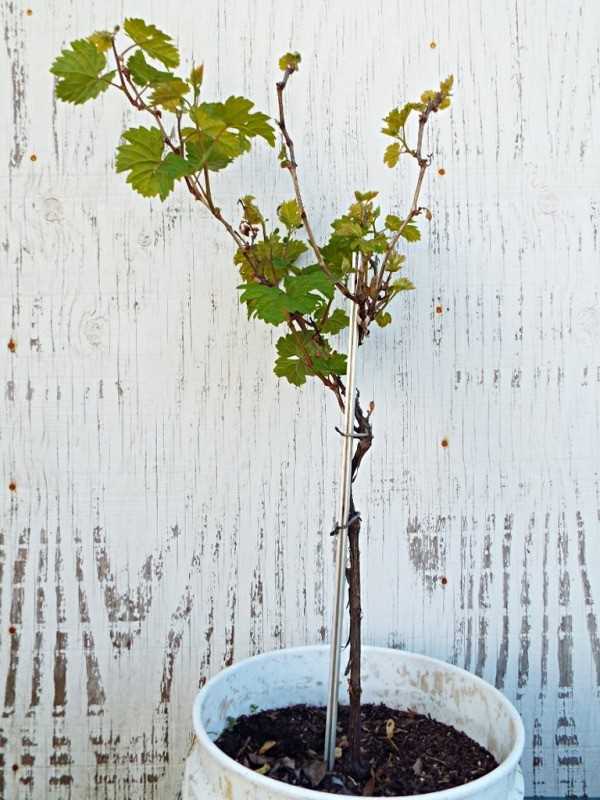

Based on the results of the soil test, apply any necessary fertilizers according to the recommended rates. This will provide the grape cuttings with essential nutrients for healthy growth.
6. Creating Planting Holes
Using a garden shovel, dig planting holes that are approximately twice the width and depth of the grape cuttings’ root system. Space the holes about 6-8 feet apart to allow sufficient room for the plants to grow and spread.
7. Watering
Before planting the cuttings, thoroughly water the prepared soil to ensure it is moist but not soggy. This will help settle the soil and provide a good foundation for the grape cuttings.
By properly preparing the soil for planting grape cuttings in autumn, you will create an optimal environment for their growth and increase the chances of a successful harvest in the future.
Creating the Proper Planting Hole
When planting grape cuttings in autumn, it is essential to create the proper planting hole to ensure the success of your vineyard. Follow these steps to create an ideal planting hole:
- Choose a suitable location: Find a spot in your vineyard that receives full sun and has well-draining soil. Avoid areas with heavy clay or standing water.
- Dig a hole: Dig a hole that is at least 12 inches deep and 12 inches wide. Make sure the hole is large enough to accommodate the grape cutting’s root system.
- Remove obstacles: Clear the area of any rocks, weeds, or roots that may obstruct the growth of the grape cutting’s roots.
- Amend the soil: Mix organic matter, such as compost or well-rotted manure, into the soil to improve its fertility and drainage.
- Prepare the grape cutting: Trim any broken or damaged roots and remove any leaves or buds from the cutting.
- Place the grape cutting: Carefully place the grape cutting in the center of the planting hole, ensuring that the roots are spread out and facing downwards. The cutting should be positioned at a slight angle, with the bud union above the soil line.
- Backfill the hole: Fill the hole with the amended soil, gently firming it around the grape cutting’s roots. Be careful not to cover the bud union with soil.
- Water thoroughly: After planting, water the grape cutting thoroughly to settle the soil and provide moisture to the roots.
- Provide support: Install a trellis or other support system near the grape cutting to ensure proper growth and development.
By creating the proper planting hole, you are setting your grape cuttings up for success. Remember to provide regular care and maintenance to ensure healthy and productive grapevines.
Ensuring Proper Drainage for Successful Planting
Proper drainage is crucial for the success of planting grape cuttings in autumn. By ensuring that excess water can easily drain from the soil, you can prevent waterlogged conditions that can lead to root rot and other problems.
1. Choosing well-draining soil
Start by selecting a well-draining soil mixture for planting your grape cuttings. Avoid heavy clay soils that retain water and instead opt for a loamy soil mixture that allows water to percolate through easily.
2. Preparing the planting site
Before planting your grape cuttings, it’s important to prepare the planting site to promote proper drainage. Clear away any weeds or debris and dig a hole that is deep enough to accommodate the roots of the cutting.
3. Amending the soil
If your soil doesn’t have good drainage, you can improve it by adding organic matter such as compost or well-rotted manure. This will help loosen the soil and improve its ability to drain excess water.
4. Creating a drainage slope
To further enhance drainage, consider creating a gentle slope in the planting area. This will allow water to flow away from the grape cuttings and prevent it from pooling around the roots.
5. Using raised beds or mounds
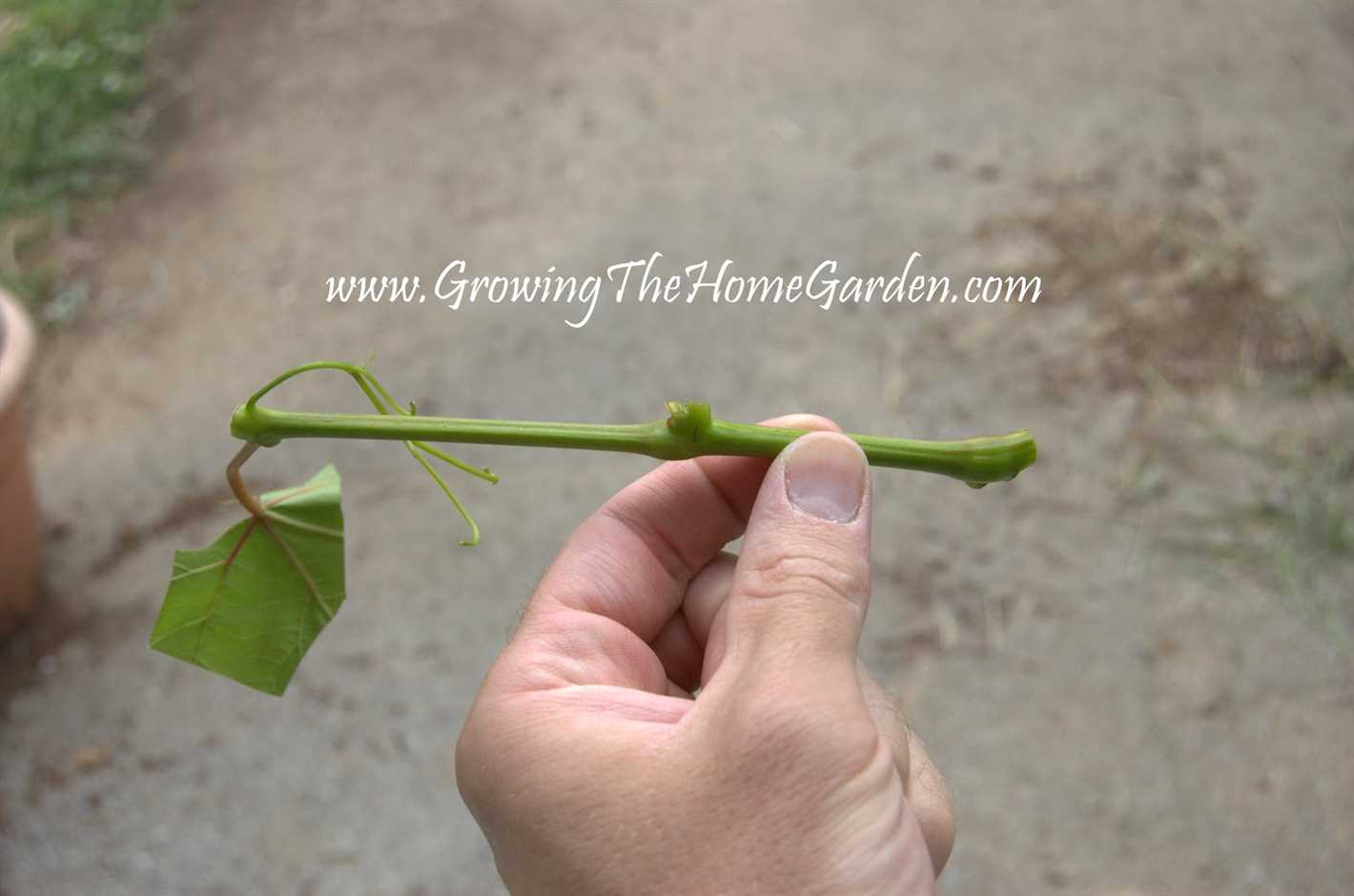

If your soil has poor drainage, using raised beds or mounds can be an effective solution. This will elevate the planting area and provide better drainage for the grape cuttings.
6. Adding drainage materials
In some cases, it may be necessary to add drainage materials such as coarse sand or gravel to improve soil drainage. These materials can be added to the planting hole or incorporated into the soil mixture.
7. Monitoring moisture levels
Once the grape cuttings are planted, it’s important to monitor the moisture levels in the soil. Avoid overwatering, as this can lead to waterlogged conditions. Let the soil dry out slightly between waterings to prevent root rot.
By ensuring proper drainage during the planting process, you can create optimal conditions for the growth and development of your grape cuttings. This will increase your chances of success and help you establish healthy grape vines in your garden.
Planting the Grape Cuttings
Proper planting techniques are essential for the successful growth and development of grape cuttings. Follow these steps to ensure your grape cuttings have the best start:
1. Select a Suitable Planting Site
Choose a location that receives at least 6 hours of direct sunlight per day. The soil should be well-drained and fertile, with a pH level between 5.5 and 7.5. Avoid areas prone to frost or excessive wind.
2. Prepare the Soil
Clear the planting site of any weeds or vegetation. Dig a hole that is wide and deep enough to accommodate the grape cutting’s root system. Loosen the soil at the bottom of the hole and mix in compost or well-rotted manure to improve fertility.
3. Prune the Grape Cutting
Before planting, prune the grape cutting to ensure a healthy and vigorous plant. Cut the cutting back to a single stem with 2-3 buds. Remove any damaged or diseased parts.
4. Plant the Grape Cutting
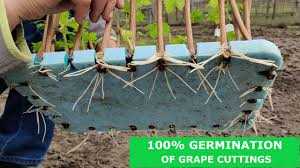

Place the grape cutting into the prepared hole, ensuring that the buds are facing upward. Backfill the hole with the soil mixture, gently firming it around the cutting to eliminate air pockets. Leave a small mound of soil around the base to retain moisture.
5. Water the Grape Cutting
After planting, thoroughly water the grape cutting to settle the soil. Water regularly, keeping the soil moist but not waterlogged. Gradually reduce watering as the grape cutting establishes its roots.
6. Provide Support
Grapevines require support for proper growth. Provide a trellis, arbor, or other suitable structure for the grape cutting to climb. Attach the stem to the support using soft ties or twine, being careful not to damage the plant.
7. Monitor and Maintain
Regularly monitor the grape cutting for signs of pests, diseases, or nutrient deficiencies. Prune as necessary to control growth and promote fruit production. Apply mulch around the base of the plant to conserve moisture and suppress weeds.
By following these planting techniques, you will give your grape cuttings the best chance of thriving and producing delicious grapes in the future.
Caring for Newly Planted Grape Cuttings
After planting your grape cuttings in autumn, it is important to provide proper care to ensure their successful growth. Here are some tips for caring for newly planted grape cuttings:
1. Watering
- Water the grape cuttings immediately after planting to ensure that the soil is moist.
- Monitor the moisture level of the soil and water the plants regularly, especially during dry spells.
- Avoid overwatering as it can lead to root rot. Allow the soil to dry slightly between watering.
2. Mulching
- Apply a layer of mulch around the base of the grape cuttings to help retain moisture, suppress weeds, and regulate soil temperature.
- Choose organic mulch, such as straw or wood chips, and spread it in a layer about 2-3 inches thick.
- Avoid piling mulch directly against the stem of the grape cutting to prevent rotting.
3. Fertilizing
- Wait until the following spring to fertilize newly planted grape cuttings.
- Apply a balanced fertilizer according to the manufacturer’s instructions.
- Consider using compost or well-rotted manure as a natural fertilizer alternative.
- Avoid over-fertilizing, as excessive nutrients can lead to vigorous vegetative growth at the expense of fruit production.
4. Pruning
- Do not prune newly planted grape cuttings until the following dormant season.
- During the first pruning, remove any dead or damaged wood and shape the plant’s structure according to the desired training system.
- Pruning helps promote proper airflow, sunlight penetration, and fruit production in grapevines.
5. Protection
- Protect the newly planted grape cuttings from extreme weather conditions, such as frost or strong winds.
- Consider covering the plants with frost blankets or providing temporary windbreaks if necessary.
- Regularly inspect the new growth for signs of pests or diseases and take appropriate measures.
By following these care tips, you can ensure the healthy establishment and growth of your newly planted grape cuttings. Remember to adapt the care routine based on specific grape varieties and local climate conditions for the best results.
Monitoring the Growth and Development
Monitoring the growth and development of newly planted grape cuttings is essential to ensure their successful establishment and long-term health. Regular monitoring allows grape growers to identify any issues or deficiencies early on and take appropriate action to remedy them. Here are some important factors to monitor:
1. Watering
Proper watering is crucial for the initial growth of grape cuttings. Regularly check the soil moisture and ensure that it is consistently moist, but not waterlogged. Avoid overwatering, as excessive moisture can lead to root rot and other diseases. On the other hand, insufficient watering can result in wilting and stunted growth.
2. Leaf Development
Monitor the development of leaves on the grape cuttings. Healthy cuttings should produce new leaves that are vibrant green and free from any signs of discoloration or damage. Yellowing or browning of leaves may indicate nutrient deficiencies or other issues that need to be addressed.
3. Shoot Growth
Keep an eye on the growth of new shoots on the grape cuttings. Adequate shoot growth is an indication that the cuttings have successfully established their root system and are actively growing. However, excessively vigorous shoots may need to be pruned to ensure balanced growth.
4. Pest and Disease Control
Regularly inspect the grape cuttings for any signs of pests or diseases. Common grape pests include aphids, mites, and grapevine leafhoppers, while common diseases include powdery mildew and downy mildew. Implement appropriate pest and disease control measures as needed to prevent damage to the cuttings.
5. Nutrient Levels
Monitor the nutrient levels in the soil to ensure that the grape cuttings have access to the necessary nutrients for optimal growth. Soil testing can help determine any deficiencies or imbalances in nutrient levels and guide the application of fertilizers or soil amendments.
6. Support and Training
As the grape cuttings grow, provide appropriate support and training to guide their growth and prevent damage. Install trellises or other support systems and use ties to secure the growing shoots to prevent bending or breakage. Regularly check and adjust the support structures as necessary.
By closely monitoring the growth and development of newly planted grape cuttings, growers can ensure that the plants are on track for healthy growth and successful establishment. Timely interventions and adjustments can be made to address any issues and promote the long-term health and productivity of the grape vines.
Question-answer:
What are some pruning techniques to consider when planting grape cuttings in autumn?
When planting grape cuttings in autumn, it is important to consider certain pruning techniques. First, you should remove any damaged or diseased wood from the cuttings. This will help prevent the spread of diseases. Additionally, it is recommended to prune back the vines to a manageable size. This will help promote healthy growth and make it easier to train the vines. Lastly, you may want to consider pruning back some of the lateral shoots to encourage stronger development. By following these pruning techniques, you can increase the success of planting grape cuttings in autumn.
What are the proper planting methods for grape cuttings in autumn?
Proper planting methods are essential when it comes to planting grape cuttings in autumn. First, you should choose a suitable location for the grapevines. Grapevines require full sunlight and well-drained soil, so make sure to select a spot that meets these criteria. Before planting, it is recommended to dig a hole that is large enough to accommodate the entire root system of the grape cutting. Gently place the cutting in the hole, making sure that the roots are spread out evenly. Fill the hole with soil, making sure to firmly press it down around the cutting. Finally, water the newly planted grape cutting thoroughly to ensure proper hydration.
Can grape cuttings be planted in autumn or should I wait until spring?
Grape cuttings can indeed be planted in autumn. In fact, autumn is often considered the best time to plant grape cuttings. The cooler temperatures and ample moisture in the soil provide optimal conditions for root development. Planting in autumn allows the grape cuttings to establish their root systems before the onset of winter. This gives them a head start for growth in the following spring. So, if you have grape cuttings ready to be planted, autumn is a great time to do it.
What happens if I don’t prune grape cuttings when planting them in autumn?
If you don’t prune grape cuttings when planting them in autumn, it can have negative effects on their growth and overall health. Pruning is essential to remove any damaged or diseased wood, which can spread diseases to the entire plant. Additionally, by pruning back the vines, you can promote better air circulation and reduce the risk of fungal infections. Pruning also helps to shape and train the vines, making them more manageable. Without proper pruning, the grape cuttings may struggle to grow properly and may not reach their full potential.
What are some common mistakes to avoid when planting grape cuttings in autumn?
When planting grape cuttings in autumn, there are a few common mistakes that should be avoided. First, make sure to choose the right location for your grapevines. They require full sunlight and well-drained soil, so planting them in a shaded area or in soil that retains too much water can hinder their growth. Another mistake to avoid is planting the grape cuttings too deeply. Make sure to plant them at the appropriate depth, with the roots spread out evenly. Lastly, make sure to water the newly planted cuttings regularly, as inadequate watering can lead to dehydration and poor growth. By avoiding these common mistakes, you can increase the success of your grape cuttings in autumn.







